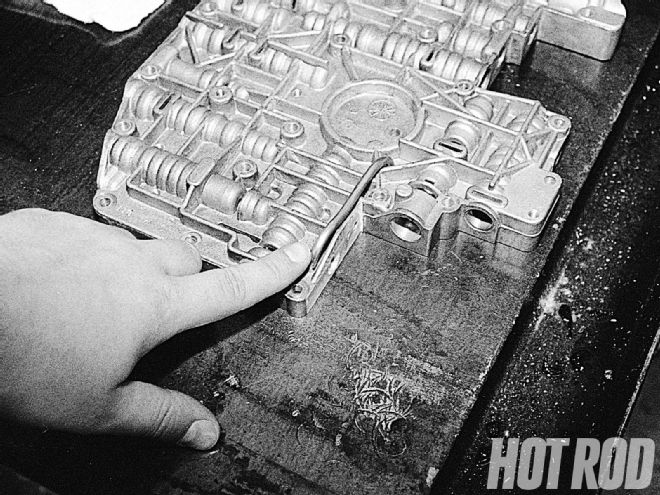
We've all got to believe in something. I know adults who insist that the world is flat, and I know those who believe in the Easter Bunny. And then there's Len Bertrand. Bertrand believes that the Ford AOD transmission is going to replace the Turbo 400 as the performance transmission in the 21st century.
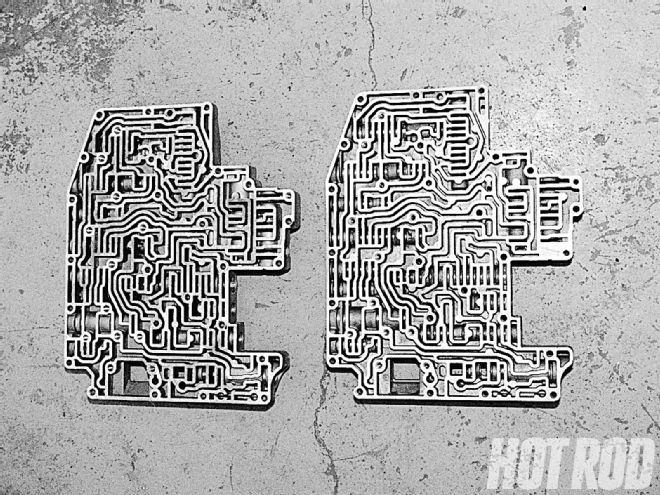 The valvebody (upper right) is completely stripped and cleaned, and all valves and springs are removed and are later reused (save for the Third-Fourth outer valvebody spring, which is omitted). With the altered valvebody (the recipient of a dozen separate modifications), extra clutches, and higher pressures everywhere, Bertrand believes that stiffer springs are unnecessary for firmer shift feel.
The valvebody (upper right) is completely stripped and cleaned, and all valves and springs are removed and are later reused (save for the Third-Fourth outer valvebody spring, which is omitted). With the altered valvebody (the recipient of a dozen separate modifications), extra clutches, and higher pressures everywhere, Bertrand believes that stiffer springs are unnecessary for firmer shift feel.
Stop laughing. We know Ford's autobox is a weak suck. By leaving Second gear off the shift pattern (some cynics speculate for cost reasons), the AOD has been doomed to languish on the performance sidelines. Second gear is accessible when you shift an AOD manually, but only after you jam the lever into Drive and then, hideously, back into First. All that 1-D-1 box banging wreaks havoc on the bands and clutches, causing bigger messes than are seen daily on the Jerry Springer show, and makes them unreliable and ill suited to performance applications (at least by reputation).
But reputations can be turned around. Bertrand, who heads up Lentech Performance from his sleepy Richmond, Ontario, Canada, digs, is spearheading the AOD's march from the nether regions of performance respectability. After 10 years of pokin', he has discovered the secrets of making this transmission sturdier than a Turbo 400 and with the benefit of Overdrive.
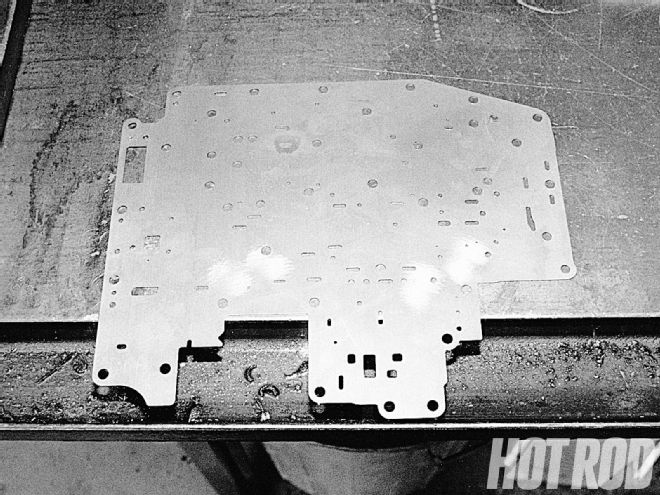 Strategically placed dowels block passages and direct fluid for added pressure, while some epoxied passages help change the shift pattern from First-Third-Fourth to First-Second-Third... as it should be. Ford offered four separate valvebodies throughout the life of the AOD... none are preferable, but '89-and-up versions have the correct separator plate (right) for Bertrand's needs, although the plate (PN E9AZ-7L228-A) easily retrofits the other valvebodies. The separator plate is also plugged.
Strategically placed dowels block passages and direct fluid for added pressure, while some epoxied passages help change the shift pattern from First-Third-Fourth to First-Second-Third... as it should be. Ford offered four separate valvebodies throughout the life of the AOD... none are preferable, but '89-and-up versions have the correct separator plate (right) for Bertrand's needs, although the plate (PN E9AZ-7L228-A) easily retrofits the other valvebodies. The separator plate is also plugged.
Bertrand has plenty of raw material to work with: The AOD appeared in millions of LTDs, Mustangs, Fairmonts, and light-duty trucks from 1980 to 1993. His plan to overthrow the Turbo 400, current King of Performance Transmissions, is a crafty one-Bertrand feels that Ford's cogswapper has plenty going for it. Compared to a TH400, the AOD is 30 pounds lighter (thanks mostly to an aluminum valvebody and a far lighter center-support section), its rotating mass is 4 pounds lighter and 1 inch trimmer in diameter (6 3/4 inches versus 5 3/4 for the AOD), and comes with all of the benefits that this difference implies. Other advantages over a TH400 include a thinner pump gear, which reduces drag for a given line pressure; a beefier intermediate sprag; and both sets of planetary gears living within a single carrier (rather than the two carriers and two sets of pinions peculiar to the TH400). With some cunning piracy from the later AODE and the Ford parts catalog, plus a healthy dose of valvebody reengineering, Bertrand has created a transmission that's as beefy as a Turbo 400 and can support more than 1,200 hp-enough to handle all but the hairiest race applications. One of Bertrand's customers runs a 1,100hp small-block Camaro in the 9s and is backed with an AOD, which, in two hard seasons, has not yet failed.
Traditionally, the AOD's big bugaboo has been unreliability; it's also notorious for bopping back and forth between Drive and Overdrive in traffic. The AOD features a complicated twin input-shaft system-the outer shaft controls Reverse, First, and Second gear clutches via the torque converter; the inner shaft, driven directly off the engine, controls Overdrive. Third gear is split between the two shafts (60 percent goes through the small inner shaft, which is prone to breakage). This unusual system can accommodate up to 450 hp or so before pieces start snapping. A sturdier single-shaft arrangement keeps the converter from locking up in Third and Fourth gears, and this alone makes a worked AOD effective into the 600hp range.
But a quick fix like a single-input shaft wasn't enough for Bertrand. He has discovered the secret to AOD reliability: He engineers the valvebody to engage the Reverse and Third clutches simultaneously when the AOD is in Third gear, thus relieving the tremendous stress placed on that small inner input shaft. Instead of simply locking the Third-Fourth planetary carrier to the forward sun gear as is the norm, the Reverse sun gear is also locked to the Forward sun gear, so the transmission drives off the beefy end of the input shaft. This arrangement provides 58.5 percent more clutch area than the Turbo 400 and doubles power-holding potential. Besides utter reliability for most street and race applications, this also means that there will be no more hunting for gears in slow-moving traffic: Pick a gear, and it stays there.
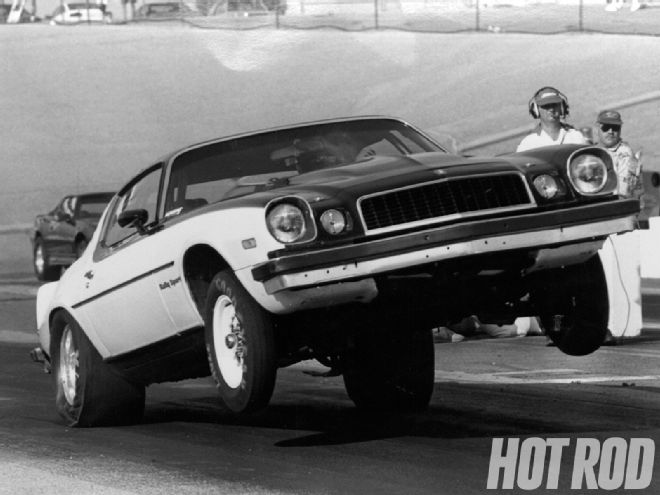
The result is a reliable automatic that feels plenty firm, will let you upshift manually or automatically (or either exclusively, depending on your needs and wants), has all the performance benefits of the GM 'box, and has the added cache of Overdrive. The OD ratio is a cushy 0.67:1, so you can effectively knock a 4.11:1 gear down to a jaw-dropping 2.75:1 when you're on the open road.
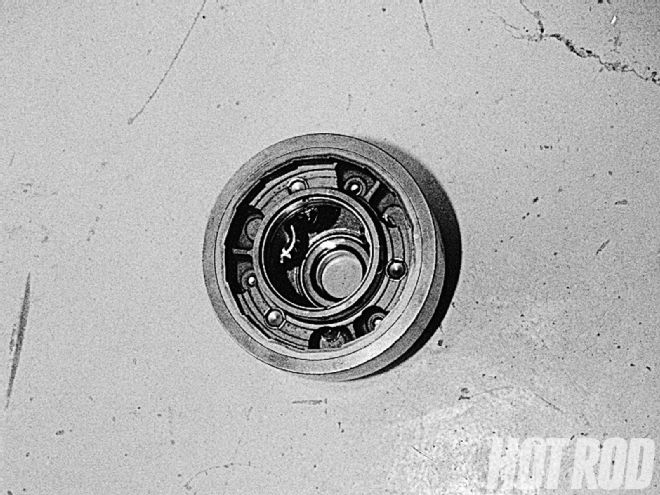 In transmissions produced from 1980-86, it was possible to starve the planetary gears of proper lubrication. The '87-and-later planetaries have a hole (located off the governor feed circuit through the output shaft) to feed pressure up to the planetary gearset... imperative for long-duration Overdrive cruising.
In transmissions produced from 1980-86, it was possible to starve the planetary gears of proper lubrication. The '87-and-later planetaries have a hole (located off the governor feed circuit through the output shaft) to feed pressure up to the planetary gearset... imperative for long-duration Overdrive cruising.
Best of all, the AOD is easily compatible with your Ford small-block. On early Mustangs, and even later intermediates like our long-suffering '70 Montego, you just need a C6 crossmember and tranny mount (thanks to Dearborn Classics for ours), for a direct bolt-in. You can even use the same driveshaft despite the 1/2-inch difference in length. Our torque converter is a 10-inch, 2,800rpm-stall design built to Bertrand's exacting specifications. Is Bertrand nuts to hop up the Ford AOD? Maybe. Then again, we believe the Easter Bunny story, too.
GM + AOD = ??
We mentioned that Len Bertrand has several of his AODs running behind GM powerplants-namely Jerry Otley's 1,100hp, nitrous-fed small-block '76 Camaro and a Buick 3.8 Turbo in Chris Nowak's Chevy II. Neither has suffered a tranny failure. Intrigued? An AOD will mate to any GM engine with minimum trouble. The adapter plate works with any SB Chevy or Buick-Olds-Pontiac (including the Turbo V-6). If your AOD will replace a Turbo 400, Bertrand recommends a 31-spline 4x4 AOD output shaft for both length and strength. Additionally, the tailshaft housing has to be slightly altered-nothing horrible, just a quick chop 'n' weld, as above, to make the AOD tailshaft the same length as a Turbo 400 tailshaft. Both mounting pads remain, meaning you can put a Ford AOD in your Camaro, or you can drop a small-block Chev into your Mustang, and the tranny will fit. Twisted, eh?